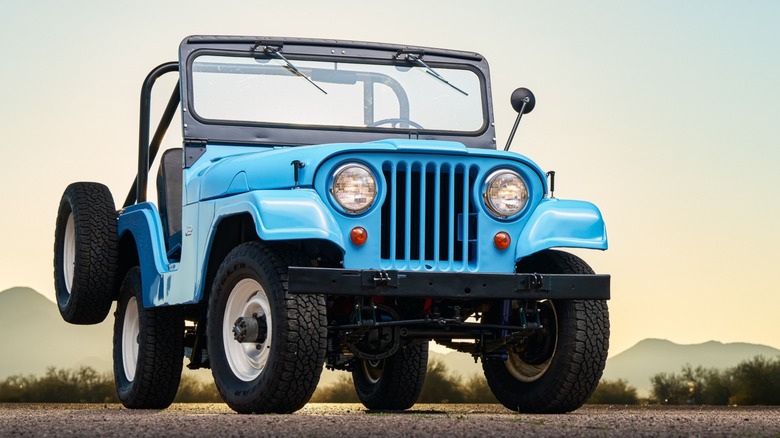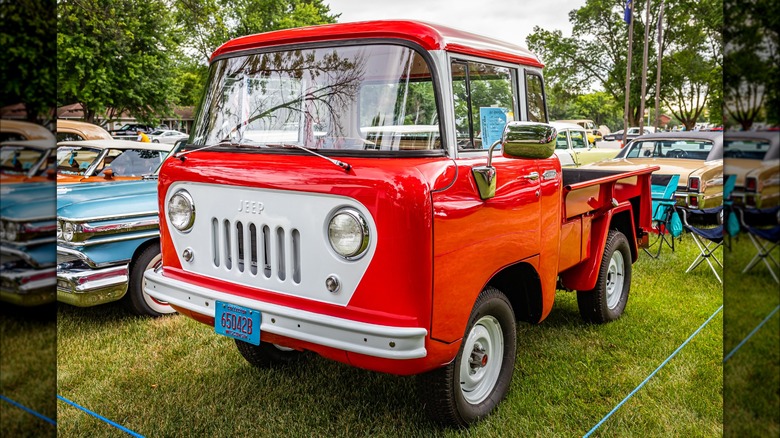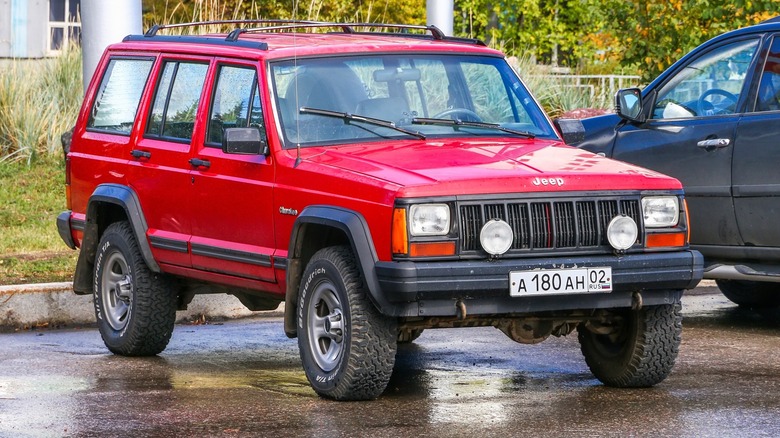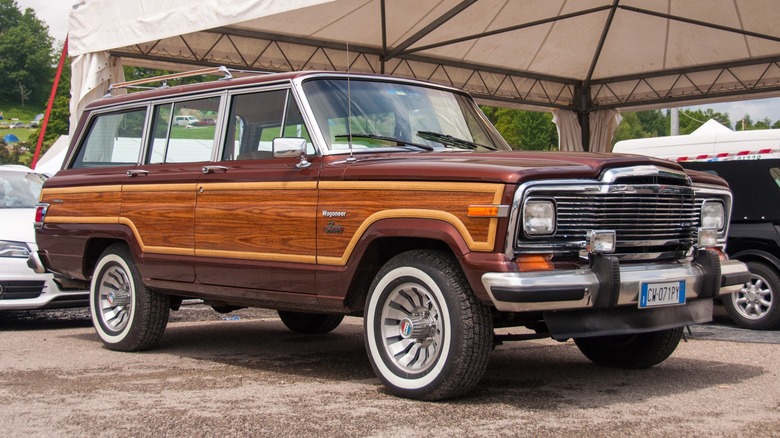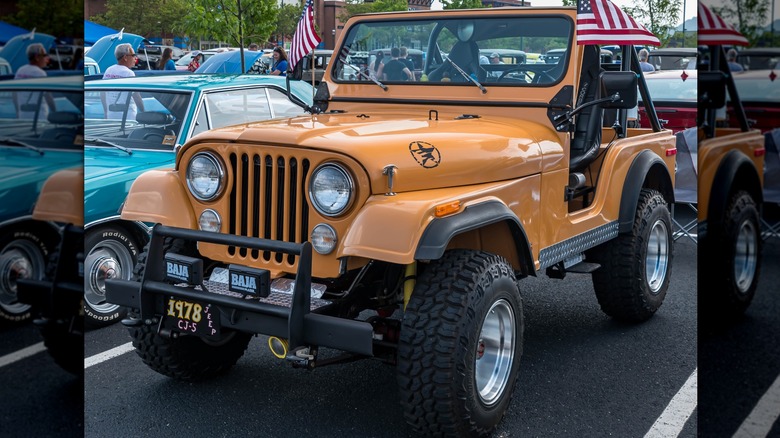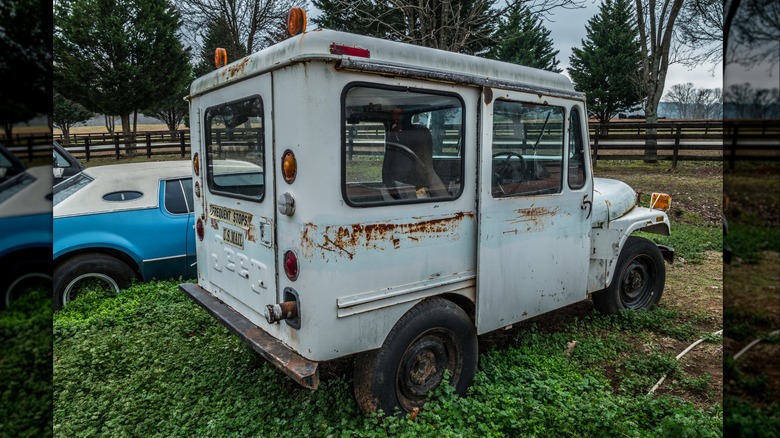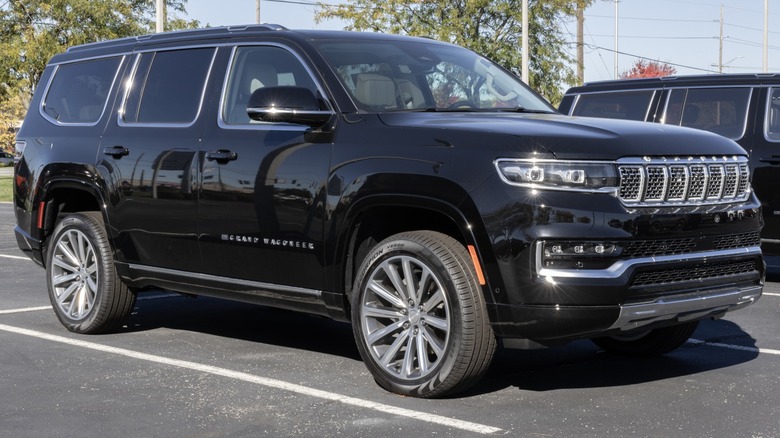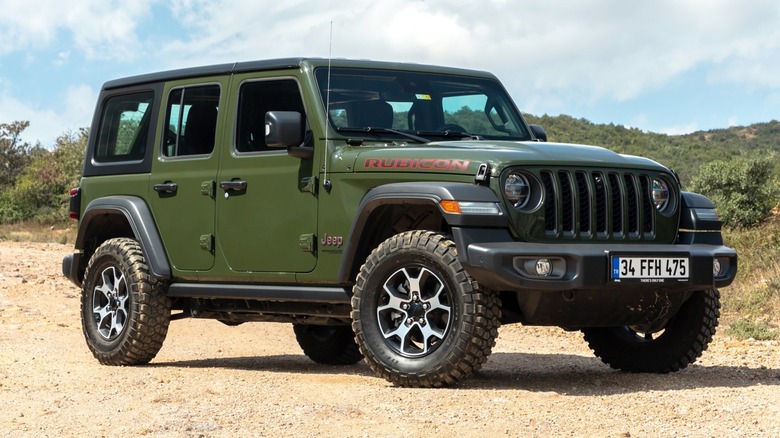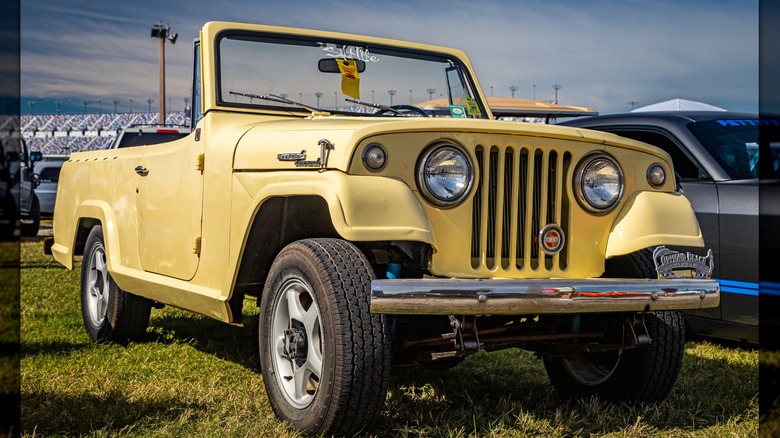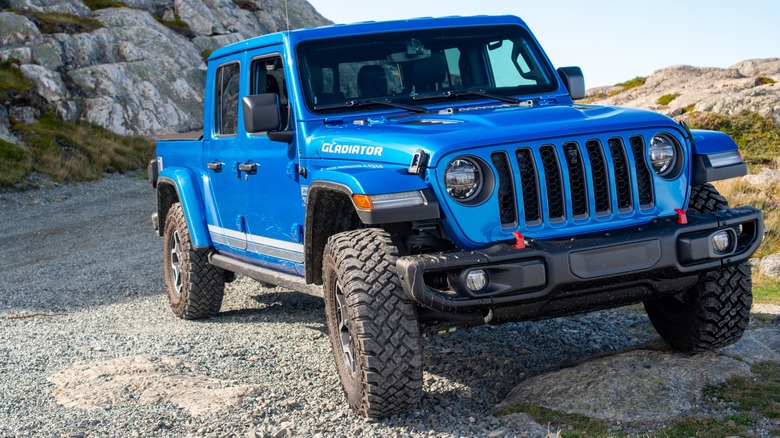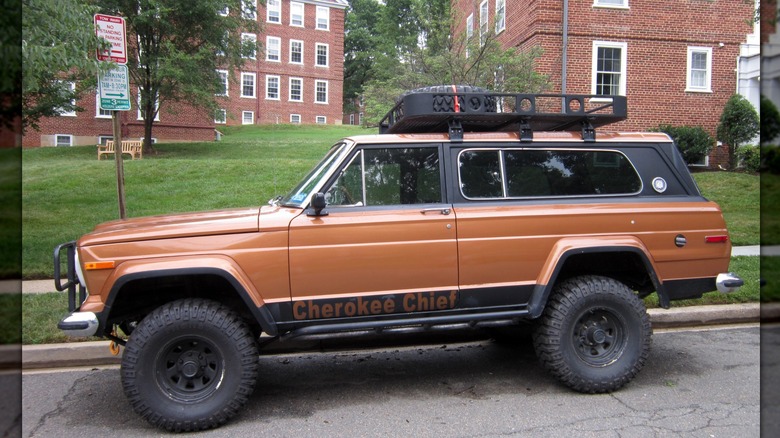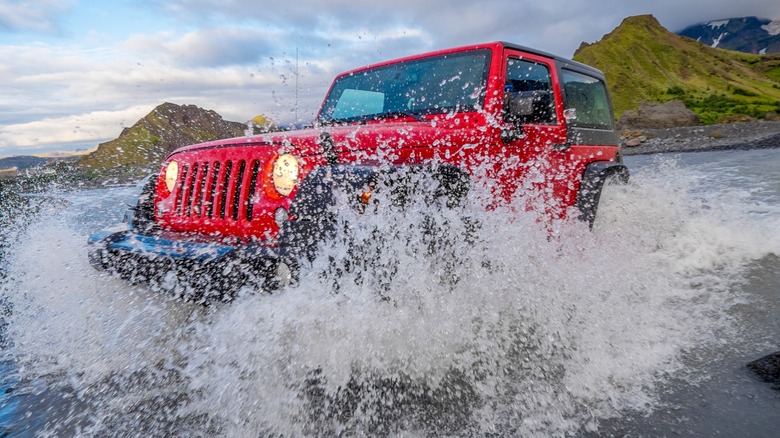The 10 Best Jeeps Ever Designed, Ranked
For decades, the venerable Jeep has been a favorite among American and international car buyers. Born out of necessity during the struggle to defeat tyranny during WWII, the Jeep emerged as one of the victors' most useful and important tools. After the war, Willys transformed production of the military vehicle toward civilian use, creating an icon of the American road that has endured as an indelible part of automotive culture ever since.
Through the years, the Jeep brand has offered a limited range of vehicles based on the original military design and from original platforms. Some of these have been wildly successful while others languished in showrooms. However, a lack of sales success has not meant some models were altogether lacking or downright bad when viewed through retrospective lenses. Some less successful models could be desirable and valuable collector's models today. Regardless, Jeep has delivered a range of fantastic off-roading vehicles over the years, and these models represent the best designs to have come from the manufacturing plants of Jeep.
Jeep FC-170
Early civilian Jeeps were marketed toward agricultural buyers who could adapt them for farm work and take advantage of their adept capabilities off the road. Jeep provided the means to add implements taking power from the engine, transforming the vehicles into pseudo tractors that could also be driven to market. As an evolution of this concept, a truck was added to the lineup in 1956.
This rugged Jeep truck was known as the Jeep FC-170 — the FC stands for forward control. Controls of this cabover truck are placed ahead of the front wheels, hence forward control. The cabover design allowed Jeep to make the most of the space and offer a truck with an incredibly tight turning radius and excellent visibility. The other advantage of these design choices was the ability of parent company Willys to build a new truck on the existing chassis of its CJ-5 Jeep.
The FC is a spartan workhorse with zero creature comforts. Yet, its peculiar design makes for an endearing classic truck when viewed through modern spectacles. Part of its allure comes from its aesthetic qualities, courtesy of renowned industrial designer Brooks Stevens, and the other part lies in the inherent quirkiness of its forward-control layout. While modern collectors may be in love with these unique trucks, Jeep only sold about 30,000 models in total, making them a rare sight today.
Jeep Cherokee XJ
Next to the CJ and Wrangler models, the XJ Cherokee is likely the best-known Jeep model. Introduced in 1984, this new Jeep borrowed its name from an existing full-size model and came with an upscale cousin which also borrowed its name, Wagoneer. Its construction represented a departure from tradition by merging the box frame and body into a single unit, providing more strength and rigidity with less weight. Furthermore, its smaller size and simple yet elegant design made for an attractive and enduring package that was a wildly successful model in Jeep's lineup, nearly unchanged until 2001 — an eternity for any automobile.
What made the Cherokee work so well was a combination of impressive capabilities coming from tried and tested 4x4 components mated to a durable and torquey 4.0-liter straight-6 engine. Though straight and boxy, the Cherokee was attractive and could be had with nicely appointed and comfortable interiors. It was the vehicle to do everything.
Upon its debut, the Cherokee earned 4x4 of the year from all three of the top off-road magazines of the day. The formula for it worked so well that it remained in production until 2001 using the same design with only a refreshed front fascia in 1997 — even the straight-6 engine remained until the model's discontinuation. With the onslaught of smaller SUVs and crossovers in the following decades, it's hard not to make an assumption that the 1984 Cherokee played a large part in the phenomenon.
Jeep Grand Wagoneer SJ
While Americans are today accustomed to large SUVs with seating for six or more passengers, the roads were markedly different in 1963. Just before then, Kaiser Motors, which took over production and ownership from Willys-Overland in 1953, needed something to sell with broader appeal than the rugged wartime-derived CJ model. A new wagon was developed to offer comfortable seating for a family with room for luggage that retained the off-road prowess of its existing models. This vehicle would become known as the Wagoneer, an icon of the road for a generation.
Known internally as the Full-Size Jeep, its internal designation eventually shortened from FSJ to simply SJ. Like the FC truck, this one was also designed by Brooks Stevens, and its longevity in the market is perhaps a testament to the brilliance of his industrial design. The debut model came with a modest 140-horsepower Tornado inline-6 and became the first 4x4 vehicle offered with an automatic transmission, and a rear-wheel-drive-only option went away in 1969.
From 1978 the Wagoneer moved upscale into a luxury flagship model for Jeep, receiving the updated Grand Wagoneer moniker. These relatively powerful and well-appointed models represent the finest of the Wagoneer. Although still capable of tearing up the side of a mountain, they became a sort of prototype for the Escalades, Navigators, and Lexus GX models that followed. The market for Grand Wagoneers is strong today with values running from $24,000 to $54,000 and recent sales as high as $177,000.
Jeep CJ
It's hard to overstate the impact of the original Willys MB light military transport on not just WWII, but on society. However, wartime production ended, leading to adaptation to civilian models. Modest changes were made and production of a civilian version commenced in July of 1945. This was dubbed the CJ-2A, and an evolution of this naming system continued until it was replaced by Wrangler in 1986.
While early models were strictly utilitarian, they quickly transformed from rugged workhorses into play toys for adventurers, and Jeep capitalized on this trend early on. TV advertisements as early as 1959 touted its workability and penchant for adventure. Introduced for the 1955 model year, the CJ-5 established Jeep as a rugged and capable off-road vehicle with sporting credentials for free-wheeling fun. Its long run through 1985 also firmly established the image of what a Jeep should be.
The CJ-5 spawned several variants and special editions contributing to the colorful legacy of the Jeep brand. The CJ-6 extended the wheelbase and sported olive green paint for military use while the later CJ-7 debuted in the '70s as a slightly longer wheelbase version for consumers, and the rare CJ-8 truck-like Scrambler sold from 1981 to 1986. Special editions include the Renegade, Laredo, and the Golden Eagle, which looks much like Daisy Duke's Jeep in the "Dukes of Hazzard." Despite being spartan and utilitarian, the CJ still holds a special appeal that plush and modern Jeeps never will.
Jeep Dispatcher
As it was born out of a military contract, Jeep maintained strong ties with the government fulfilling contracts for military transport. Therefore, Jeep was well positioned to fulfill a contract supplying the United States Postal Service with mail delivery vehicles based on a call to test and develop new models in 1954. This was the first time the USPS commissioned a purpose-built vehicle, resulting in thousands of postal Jeeps visiting American homes every day but Sunday for decades.
The official model name of the postal Jeep is the Dispatcher. It rode on the same chassis as the CJ model from the year of development with the driver position moved to the right, an enclosed cargo box built onto the body, and a sliding door for easy access. They were offered in left- or right-hand drive with a choice of hard or canvas top and were offered to institutions other than the USPS, including the Jeep Gala, painted bright pink with a fringe top.
The choice of Jeep for mail delivery made sense as its 4-cylinder engine was economical, the suspension could handle cargo, and it would have no trouble delivering to the vast expanses of rural space across the country, but with no amenities whatsoever. They were replaced by the soon-to-be-replaced Grumman LLV in 1987. Regardless, they are true American icons that remain such a beloved part of the country's history, the USPS sold die-cast replicas as recently as 2020, more than 30 years after being retired.
Jeep Grand Wagoneer WS
While the Grand Wagoneer of the '80s ushered in a level of luxury never before seen in Jeep vehicles, the re-introduction of the name ushers in a level of luxury exceeding not just Jeep, but many of its peers. After a couple of years of dormancy, Jeep revived the name for the 2022 Grand Wagoneer, which arrived with an imposing stature and filled with opulence usually reserved for luxury-only brands.
Jeep revealed a Wagoneer concept in 2020 indicating that it was headed for production as a 2022 model as part of a future Wagoneer line of vehicles. Looking back, the concept was actually a fully fleshed-out model as little changed when production models arrived. Regardless, the new Grand Wagoneer took its place atop the Jeep hierarchy as a large family-friendly luxury leader that happens to have classic Jeep off-roading skills in abundance. Unlike moderately priced Jeeps of old, retail on this one started near $100,000 and surpassed it on nicely trimmed models. It has only become more expensive in the intervening two years.
The new model looks to be ushering in a new upscale era for the Jeep brand, and it appears to be doing so with aplomb. There likely won't be many of these getting down and dirty in a few inches of mud, but it is nice to think that if one wanted to get their $100,000 Grand Wagoneer caked in filth without getting stuck, they could.
Jeep Wrangler
After decades of producing essentially the same hardy off-roader, Jeep gave it an overhaul while nixing the alphanumeric naming and dubbed it the Wrangler. While this model underwent many changes at the time, perhaps none had the visual impact of the iconic round headlamps, jettisoned in favor of a pair of rectangles. This followed 1980s design trends favoring angular designs and sharp creases. It was still unmistakably a Jeep, but transformed into a modern Jeep.
While the shape of the Wrangler largely followed its predecessor, more significant changes came underneath where suspension upgrades and a longer wheelbase contributed to increased stability, particularly on the highway. Furthermore, the newly released and wildly successful Cherokee lent its interior aesthetic to the Wrangler, which received a stylish and modern dashboard in place of the austere metal wall housing a couple of gauges. Nicely trimmed seats and durable carpet further enhanced the driving and ownership experience that, combined with a new fuel-injected 4.0-liter 6-cylinder engine, made the Wrangler a much more pleasant Jeep to live with than the outgoing model.
The Wrangler continued the Jeep tradition and its popularity has not waned. Still in production, it still honors past Jeeps while celebrating modern car design and technology. The round headlights have returned, but spartan interiors are a thing of the past as modern Jeeps are highly refined vehicles full of modern technology. With the Jeep Wrangler now in its fourth generation, its popularity remains solid and its success seems a foregone conclusion.
Jeepster Commando
The last vehicle introduced by Kaiser before selling Jeep to AMC was the 1967 Jeepster Commando, which continued to sell through the 1973 model year. This model actually resurrected the Jeepster name and layout from a model produced by the previous owner, Willys, which was produced from 1948 to 1951 in modest numbers. With stiff competition in the limited market for off-road vehicles at the time, Kaiser introduced this model to bring in buyers wanting a vehicle with more passenger and cargo space and better protection from the elements. Furthermore, it was intended to compete with the International Scout and Ford Bronco.
The Jeepster Commando was a much more sporty version of a Jeep, although it retained the same four-wheel-drive capabilities. Jeep offered it in three body styles, including wagon, convertible, and truck. Early buyers had only an old and underpowered Hurricane 4-cylinder engine with 75 horsepower or the Dauntless V6, which doubled power to about 150. While the Commando departed in styling from the CJ, it shared the spartan interior, receiving few optional extras.
AMC bought Jeep from Kaiser and a couple of years later, the Commando received a facelift and better AMC engine choices. They attempted to bring the oddball Jeep up to spec to attract new buyers but they failed to materialize. Jeep only made about 11,000 of these vehicles per year, and when the new Chevy Blazer came out in 1969, it just could not compete. It was phased out after 1973.
Jeep Gladiator JT
Under Kaiser ownership, Jeep introduced a full-size truck in the early '60s called the Gladiator. Its production ended in 1971, but the latest iteration of the Jeep brand resurrected the name for a new Wrangler-based truck in 2020. Jeep has a long history of making pickups, although they have never been a core part of the brand. The Cherokee-based Comanche was last sold in 1992, and Jeep was without a pickup all the way until the new Gladiator debuted.
The idea for the Gladiator is not new. Jeep offered its CJ-base Scrambler from 1981 to 1986, although, unlike the new pickup, it only featured two doors. The new Gladiator is based upon a four-door Wrangler and features a small pickup bed out back. It is just five feet long with a payload capacity of 1,700 pounds and is clearly not a serious work truck. Perhaps the biggest advantage this model of Jeep offers is a solid roof, allowing for better interior materials protected from the elements, such as leather.
With the 2020 Jeep Gladiator, fans of the brand may have received what they always wanted, but its appeal outside of that group may be limited. Regardless, it remains a nice addition to the lineup and having more options in vehicles to choose from is never a bad thing. Furthermore, for those wanting more adventure, Hennessey built the Maximus, a Hemi-powered Gladiator with 1,000 horsepower for $200,000, a perfect choice for drivers with more money than sense.
Jeep Cherokee Chief
Although Kaiser introduced the Wagoneer in 1963 and found success with it, AMC chose to change things up with the brand when it acquired Jeep in the '70s. As the Wagoneer had already been receiving upscale upgrades, such as power options, AMC wanted to move it further upscale into near-luxury territory. However, not wanting to eliminate the market for buyers wanting more sporty models, AMC split the model line in two and offered a two-door variant called Cherokee.
The sporty Cherokee model was introduced in 1974 and continued in production until 1983. It was discontinued to make way for what would become five generations of the successful downsized Jeep Cherokee XJ. Jeep offered a range of engines from the standard AMC straight-6 to the largest V8 ever found in a Jeep, the AMC 401 V8. The popular Cherokee Chief package debuted as a 1976 model, providing optional trim, wider fenders, and wide-track axles with larger tires, creating an imposing and impressive off-road look. A Golden Eagle package was also introduced and sold alongside the Chief in 1979 only.
When the XJ Cherokee replaced the old full-size model, it was during a time of downsizing across the industry and all manufacturers moving to more efficient platforms. With this trend, it is not likely the Cherokee Chief could have survived much longer, but it remains an integral part of Jeep history and remains a valued collectible model today.
Why are these the best Jeep models?
The truth is that maybe they are not the best performance models. However, each of these models represents something significant for the Jeep brand. They introduced a new way of building vehicles for Jeep or simply an interesting body style that maybe did not sell so well, but it is as popular as ever today. Some of these have become coveted rarities that command attention on the auction block while others simply represent the best of what the brand is right now.
The other truth about these Jeeps is that selecting the best design can be subjective and you may not agree with these picks. If you are a Jeep fan and whether you agree or not, hopefully, you will see value in reading about all of these models and possibly learn something new. Unless you are rating models using specific parameters, such as horsepower or top speed, no list will ever be definitive.
